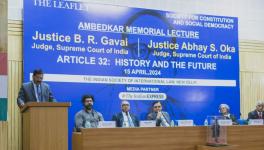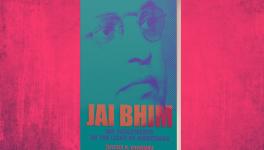The Unknown Ambedkar: India’s First Labour Minister

Representational Image.
B.R. Ambedkar realised that the labour class could not be meaningfully uplifted unless the oppressed classes were emancipated.
—
B.R. Ambedkar was not only the most important Dalit icon and a hero for aspirational classes to adore and emulate in post-independence India but also contributed immensely to the labour movement in the country.
After bagging his master’s and PhDs from Columbia University and the London School of Economics, he joined as a professor at the Government Law College, Bombay. Yet he failed to secure decent accommodation as education and distinction weren’t enough to wash off the ‘stain’ of untouchability.
For 10 years, Babasaheb resided in a chawl of the Bombay Development Department, in Parel, meant for the lowest working class, mainly employed with textile mills. The humiliation was perhaps the greatest gift to India’s labour movement. These foundational years and his brush with the daily existential struggle of the toiling poor were bound to impact the thinking and orientation of a man destined to be the first labour minister.
Ambedkar’s tryst with labour began when he was associated with the Bombay Textile Labour Union, formed in 1925 by moderates N.M. Joshi and R.R. Bakale. Ambedkar noticed that ‘high’ caste workers discriminated against their colleagues from ‘low’ castes when the latter had to wet the thread with saliva to tie the knot to replace weft bobbins— which were thus ‘polluted’.
The Great Bombay textile strike and afterwards
During the Great Bombay textile strike in 1928, Ambedkar found the opportunity to address this age-old inhumanity. He threatened communist leaders with dissuading his followers from participating in the agitation if his demand for access of ‘low’ caste workers to all jobs in mills wasn’t mentioned in the charter of demands. He succeeded, though the demand was reluctantly accepted.
Ambedkar’s tryst with labour began when he was associated with the Bombay Textile Labour Union, formed in 1925 by moderates N.M. Joshi and R.R. Bakale.
In 1936, Ambedkar formed the Independent Labour Party (ILP), which had a comprehensive manifesto on worker rights. In 1937, the party described itself as a “labour organisation” which mainly “advanced the welfare of labour classes” and was “committed to supporting state ownership and management wherever necessary”.
In the 1937 Indian provincial elections, the first under the Government of India Act, 1935, the ILP made a stunning debut by winning 15 of the 17 seats contested in the Bombay Legislative Assembly.
Disillusioned by the caste divide in the working class, Ambedkar realised that the labour class could not be meaningfully uplifted unless the oppressed classes were emancipated. It was the reason the ILP’s commitment to labour reforms in the 1940s made way for the All India Scheduled Caste Federation in 1942 with a predominant caste activism mandate.
Ambedkar summarised his divergence from Marxists by stating: “Had Karl Marx been born in India and had written his famous treatise Das Kapital sitting in India, he would have to write it in an entirely different fashion.”
In his 1936 book Annihilation of Caste, Ambedkar writes that what was implicit in the caste system was not merely the division of labour but also the division of labourers. “Now the caste system will not allow Hindus to take to occupations where they are wanted if they do not belong to them by heredity. If a Hindu is seen to starve rather than take to new occupations not assigned to his caste, the reason is to be found in the caste system,” he writes.
Ambedkar opposed the Industries Disputes Bill, introduced by the Congress government of Bombay in 1937, terming it the “Workers Civil Liberties Suspension Act” as it prescribed a six-month imprisonment for participating in an illegal strike. Opposing the Bill in the Assembly in 1938, he argued that punishing workers for participating in a strike was “nothing short of making the worker a slave”. Slavery was nothing but involuntary servitude, he added.
Despite being under British rule, India was a founding member of the International Labour Organization (ILO), established by the League of Nations in 1919. The ILO also established its branch office in Delhi in 1928. The ILO’s mantra was tripartism, i.e. the bringing together of capital and labour by the State to resolve industrial disputes, conflicts and challenges.
Labour member of the viceroy’s Executive Council
Given his deep sectoral expertise, Ambedkar was appointed as the labour member of the viceroy’s Executive Council from 1942 to 1946— a de facto labour minister of sorts by the Royal Warrant of July 20, 1942.
Ambedkar’s captaincy of the labour ministry came at a crucial time when the war economy demanded the expansion of industry and, at the same time, required the effective management of industrial disputes. His even-handedness earned him the appreciation of both capitalists and labourers. He reduced the number of working hours from 14 to 8 and announced the same at the 7th session of the Indian Labour Conference in New Delhi on November 27, 1942.
During the Great Bombay textile strike in 1928, Ambedkar threatened communist leaders with dissuading his followers from participating in the agitation if his demand for access of ‘low’ caste workers to all jobs in mills wasn’t mentioned in the charter of demands.
Days before the beginning of the Quit India movement, Ambedkar addressed the fourth Tripartite National Labour Conference in New Delhi on August 7, 1942. As a historic first at this conference, representatives of employers and employees were brought face to face. Ambedkar spoke about both the universality of labour legislation and internationalism, “Employers and employees, who were earlier not represented, would now find a seat at the High Table.” The era of tripartism had indeed dawned.
India was dragged into World War II without the British consulting Indian leaders. Congress governments in the provinces tendered their resignation in protest. The Muslim League supported the British war efforts. Ambedkar also chose to stick on.
While Ambedkar would gain wide recognition for his ability to pilot the draft of the Constitution through the arduous debates in the Constituent Assembly, many may not be aware that he had picked up the expertise and skill while defending the imperial government’s labour policies and legislation as labour minister in the Central Assembly.
Ambedkar’s legal training was an asset as he forensically broke down legislative proposals to explain the same to Central Assembly members. Crucial legislation on trade unions, maternity benefits and factories that form the backbone of industrial law were crafted under him.
Ambedkar was also a hands-on labour minister. On December 9, 1943, he visited several collieries in Dhanbad wearing a safety hat and even went down to a 400-foot-deep mine to see the working conditions of miners. He also closely watched the condition of female labourers and the amenities provided by the government and the colliery owner.
“Hum andar a sakte hain? (May I come inside),” Ambedkar asked a worker when he landed at his home to assess the living conditions of miners. The worker readily welcomed the labour minister, who inspected the room, furniture and ventilation.
Ambedkar also visited the hospital for workers and chatted with its patients. He made it a point to interact with workers and their families and encouraged them to share their experiences. For instance, he spent an hour studying the various types of houses built by the mine owner for the workers of Digwadih Collery.
It was no token gesture or a photo op— Ambedkar was genuinely interested in the living and working conditions of the workers, many of whom belonged to oppressed classes and would hail him as their messiah one day. Whether it was the leper colony in Raniganj or the school for miners’ children at Sitapur Colony, Babasaheb was one with all.
While returning to Dhanbad, he inspected the Dhowras, or tenements, at Begunia Collery and enquired about the workers’ food, clothing and health.
When Ambedkar returned to the capital, he lifted the ban on women working in underground coal mines.
A new era and a new Constitution
Ambedkar’s days as labour member were now numbered. Independence was near and the viceroy and the secretary of state for India had failed to prevail upon the Congress and the Muslim League to agree on sharing power and form a representative government. Muhammad Ali Jinnah was adamant about parity and would not accept the Congress appointing any Muslim minister out of its allotted quota. Only the league should have that prerogative. In any case, he had publicly disparaged Congress stalwart Abul Kalam Azad as a ‘showpiece’.
Ambedkar opposed the Industries Disputes Bill, introduced by the Congress government of Bombay in 1937, terming it the “Workers Civil Liberties Suspension Act” as it prescribed a six-month imprisonment for participating in an illegal strike.
When the parties finally reached an agreement, Congress had its face from the Scheduled Castes in Jagjivan Ram, who succeeded Ambedkar as labour minister. Jinnah had no hesitation in nominating another prominent Scheduled Caste politician Jogendra Nath Mandal, from Bengal, who was appointed to head the law department. Sadly, Ambedkar tendered his resignation when the Executive Council was reconstituted on August 24, 1946.
The All India Schedule Castes Federation was formed to test the electoral waters as home rule, or self-government, was becoming an inevitable reality. Sadly, Ambedkar could not win a seat in the Constituent Assembly. Mandal, who later served as Pakistan’s law minister and chairman of its Constituent Assembly briefly, ensured that Ambedkar made it to the Assembly via Bengal.
Though the Congress cold-shouldered Ambedkar during the 1946 election to the Constituent Assembly, when seats had to be reduced following the Partition in 1947, the party brought him back from the Bombay Province. Mahatma Gandhi was keen that Ambedkar should not only participate in framing the Constitution but also serve in Jawaharlal Nehru’s cabinet.
The Constituent Assembly took up the task of framing the Constitution with Ambedkar as chairman of the crucial Drafting Committee. The triumphs and tribulations of labour legislation and enforcement during British rule were etched in Ambedkar’s mind. He reminded the assembly that while India accepted many international standards of labour rights, such as the Forced Labour Convention of 1930 and enacted labour statutes, most remained on paper during British rule.
As the assembly wanted to secure ‘economic justice’, it took up the discussion on workers’ rights. The most crucial provision debated was the right to life— which ultimately would be enshrined in Article 21 of the Constitution. The assembly had to decide on whether to use the “due process clause”, as was the law in the United States, i.e. the right to life can only be impacted by the due process of law, or should a more conservative phraseology be adopted such as “procedure established by law”.
Interestingly, A.K. Iyer pointed out that the due process clause was vague and gave undue discretion to courts— which Justice Felix Frankfurter had cautioned B.N. Rau, the adviser to the Constituent Assembly, against. Iyer pointed out how the conservative US Supreme Court had invalidated beneficial labour legislation on minimum wages and restraints on employers on the grounds of being foul of “due process”.
He reminded the Constituent Assembly that while India accepted many international standards of labour rights, such as the Forced Labour Convention of 1930 and enacted labour statutes, most remained on paper during British rule.
Ambedkar passionately defended the Drafting Committee’s rejection of the due process clause in favour of the “procedure established by law” to protect the rights of labourers.
Even when the contours of the fundamental rights were being shaped— particularly, granting the freedom of trade, professional and occupation— Ambedkar advised caution. In his note on fundamental rights, he pointed out that this would be nothing other than the freedom “to increase hours of work and reduce rates of wages”.
Ambedkar agreed with communists that capitalism was the enemy of the working class. His point of divergence was that he believed Brahmanism was no lesser evil.
Unfortunately, one of the brightest minds of the Constituent Assembly wasn’t elected to the Lok Sabha in the first General Election in 1952 and he even lost in the 1954 Bhandara by-poll. Subsequently, he dissolved the federation and announced the formation of the Republican Party of India in 1956.
Sanjoy Ghose is a practising advocate in the High Court of Delhi and the Supreme Court.
Get the latest reports & analysis with people's perspective on Protests, movements & deep analytical videos, discussions of the current affairs in your Telegram app. Subscribe to NewsClick's Telegram channel & get Real-Time updates on stories, as they get published on our website.
























